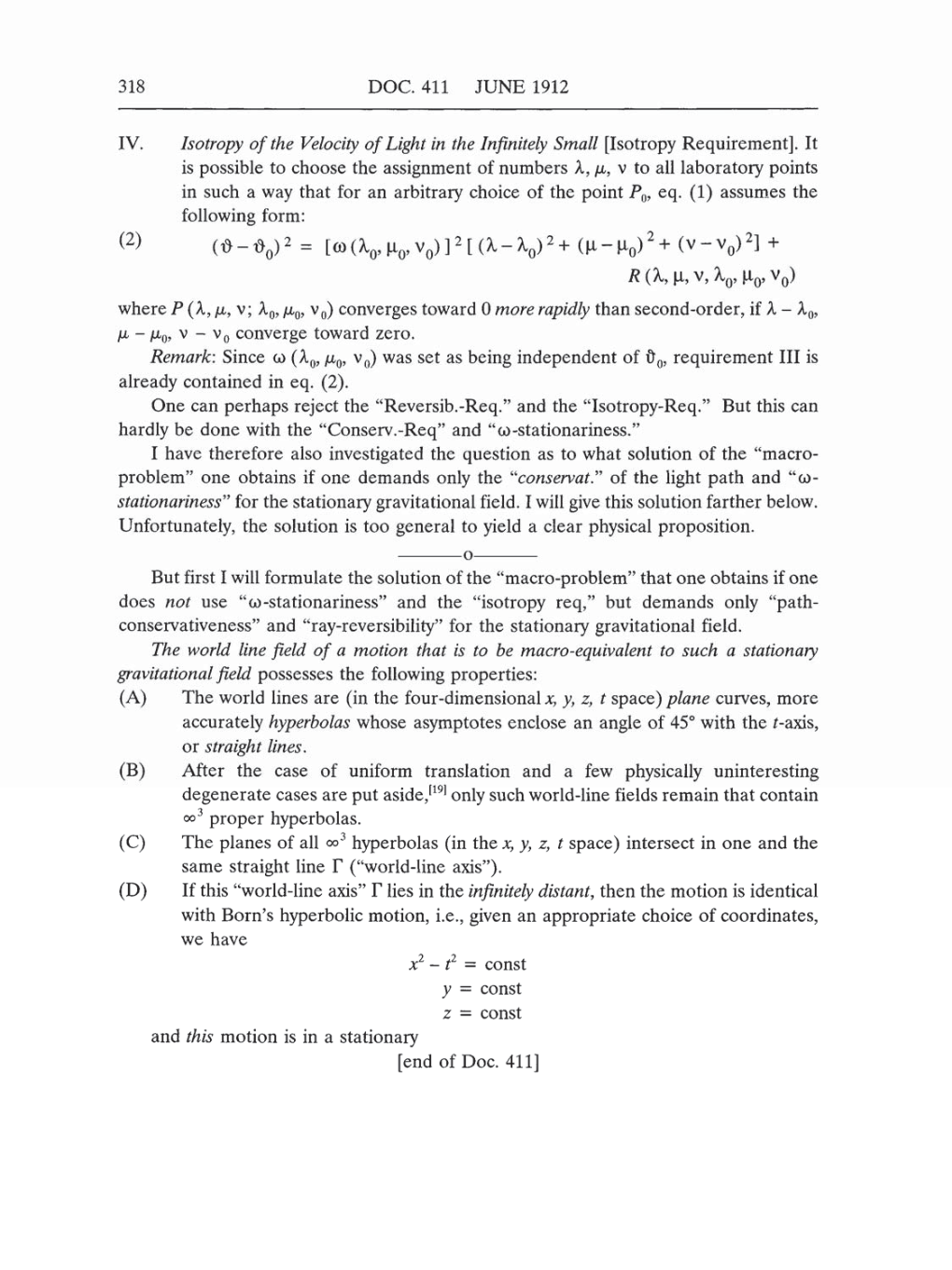318
DOC.
411
JUNE
1912
IV.
Isotropy
of
the
Velocity
of
Light
in
the
Infinitely
Small
[Isotropy
Requirement].
It
is
possible
to
choose the
assignment
of
numbers
X,
fi,
v
to
all
laboratory points
in such
a
way
that
for
an
arbitrary
choice of
the
point
P0,
eq. (1) assumes
the
following
form:
(2)
(d-d0)2=
[Ŧa0,|X0,v0)]2[a
-V2+ (l^-^o)2+ (v~vo)2]
+
R
(X,
(X,
v,
X0,
|i0, v0)
where P
(X,
v;
A0,
v0)
converges
toward
0
more
rapidly
than
second-order,
if
X
-
A0,
fx
-
fx0,
v
-
v0
converge
toward
zero.
Remark: Since
o
(A0,
fx0,
v0)
was
set
as being
independent
of
ü0,
requirement
III
is
already
contained
in
eq. (2).
One
can
perhaps reject
the
"Reversib.-Req."
and
the
"Isotropy-Req."
But
this
can
hardly
be
done
with
the
"Conserv.-Req"
and "co-stationariness."
I have
therefore
also
investigated
the
question
as
to
what solution of the "macro-
problem"
one
obtains
if
one
demands
only
the "conservat." of
the
light
path
and "co-
stationariness"
for
the
stationary gravitational
field. I will
give
this
solution farther below.
Unfortunately,
the
solution
is too
general
to
yield a
clear
physical
proposition.
o
But first
I
will
formulate the
solution
of
the
"macro-problem"
that
one
obtains
if
one
does
not
use
"co-stationariness"
and
the
"isotropy req,"
but demands
only
"path-
conservativeness"
and
"ray-reversibility"
for the
stationary gravitational
field.
The world line
field
of
a
motion
that
is
to be
macro-equivalent
to
such
a
stationary
gravitational field possesses
the
following properties:
(A)
The
world lines
are (in
the four-dimensional
x,
y,
z,
t
space)
plane curves,
more
accurately
hyperbolas
whose
asymptotes
enclose
an
angle
of
45°
with
the
t-axis,
or
straight
lines.
(B)
After the
case
of uniform translation
and
a
few
physically
uninteresting
degenerate
cases
are
put
aside,[19]
only
such world-line fields
remain that contain
oo3
proper
hyperbolas.
(C)
The
planes
of
all
oo3
hyperbolas
(in
the
x,
y,
z,
t
space)
intersect
in
one
and
the
same
straight
line
Y ("world-line axis").
(D)
If
this "world-line axis"
Y
lies in the
infinitely
distant,
then the motion
is
identical
with
Born's
hyperbolic motion, i.e., given
an
appropriate
choice
of
coordinates,
we
have
x2
-
t2
=
const
y
=
const
z
=
const
and this motion
is
in
a
stationary
[end
of
Doc.
411]
